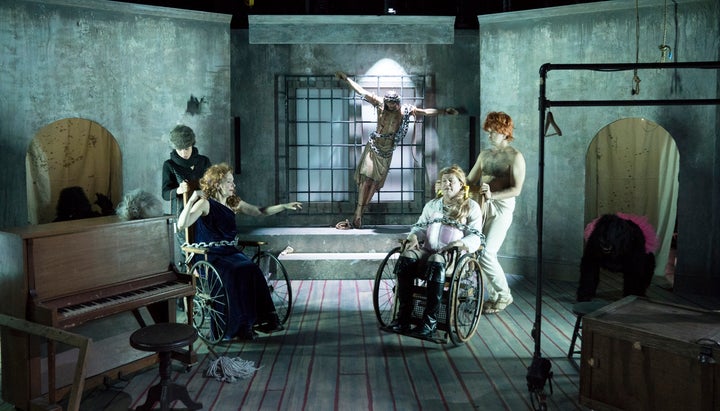
(from left to right) Jessica Weinstein, Maude Mitchell, Greg Mehrten, and Eamonn Farrell in Glass Guignol: The Brother and Sister Play.
Mary Shelley and Lord Byron walk into a theater, and begin to text about the experimental performance they are seeing. Mary Shelley is a puppet, of course, as is Lord Byron. Byron takes out his cell phone and loudly texts Shelley some questions about it, which are projected on the upstage wall and two side screens. Byron famously chiseled graffiti onto ancient Greek monuments, so he probably would have been someone who texted during the performance. Shelley responds by explaining that the performance will take concept of “readymades” made famous by artists such as Marcel DuChamp, and extend them to the textual “readymades” that they argue are contained in classic texts. She goes on to say that the thesis of this work is that certain texts contained in Tennessee Williams’s plays can be assembled to create a story of Williams’s feelings about his lobotomized sister Rose. Shelley is a fast and concise texter, as this information is set out in a few texts before she moves on to describing the setting of the first play. In other words, the first few moments of Mabou Mines’s Glass Guignol: The Brother and Sister Play literally set the stage for the layered theatrical reality we are about to enter.
Upon entering the newly revamped space that now houses the Mabou Mines Theater, 122 CC, and heading to the second floor, I was immediately greeted by a haunting noise of symphonic metal. I looked down to see a man dressed in a white union suit, playing a cylindrical instrument comprised of various lengths of metal attached to the ends of a circular form, which he played with a bow. The effect reminded me a bit of Peter Brook’s famous production of Marat/Sade, as the man seemed to me to be a “patient.” Indeed, mental health concerns are integral to this play, which interrogates the representations of Williams’s sister Rose, who underwent a prefrontal lobotomy in 1943.
Most audiences and readers know Rose’s theatrical alter-ego, Laura from The Glass Menagerie, where perceived mental illness is instead transposed to the physical difference. Reflections of Laura can also be found among the violent plants in Catherine from Suddenly Last Summer, who is threatened with a lobotomy if she does not change her story about the facts surrounding the death of her cousin, Sebastian. In the hands of co-conceivers Lee Breuer and Maude Mitchell, who know their Williams, these two well-known plays are interwoven with some more obscure plays from the Williams canon to create a new story – or rather, illuminate a very old one.
After the framework introduced by the puppet-versions of Byron and Shelley (created by the legendary Basil Twist and Hanne Tierney, respectively) the brother and sister of Glass Guignol’s subtitle appear. They are none other than Felice and Clare, the sibling-actors from Williams’s The Two-Character Play, who are determined to perform a play, despite a missing set, the desertion of their company-members, and the questionable mental state of both characters. Greg Mehrten’s Brother appears in a costume straight out of a Moliere play, complete with powdered wig. He is soft-spoken and is ambivalent about performing the play that he has written for his sister and him to perform. At moments, he seems to have given up, and yet he always manages to find the strength to continue. He prepares us for Maude Mitchell’s Sister, who is trying to cut parts of the play, because she does not wish to perform in these (mental and societal) conditions.
Instead of performing The Two-Character Play, as Felice and Clare attempt to do in the play of that name, the Brother and Sister attempt to perform The Glass Menagerie. Mehrten and Mitchell are both masterful downtown performers, and their chemistry and pure craft is on full display in this piece. They switch wigs to play Amanda, Laura, and Tom, emphasizing the connections between Williams’s most famous family play and a play with a pair of sibling protagonists. Filling out the world are the multi-talented Jessica Weinstein and Eamonn Farrell, who step into multiple plays to play. Weinstein shines as an interpreter referenced in The Two-Character Play, who must translate what the Brother and Sister say in a variety of ways, while Farrell embodies Nijinsky in a part of the play I will discuss shortly.

(l to r) Greg Mehrten, Jessica Weistein, Maude Mitchell, and Eamonn Farrell in a part of Glass Guignol that channels Suddenly Last Summer.
As the plays entering Glass Guignol’s purview become more obscure in Act II, projected titles inform the audience of works such as A Cavalier for Milady, which is perhaps my favorite Williams one-act. It involves a young woman who has been treated like a young girl by her family: given a babysitter, kept sheltered, and dressed as a child. Nance, which was also Williams’s nickname given to him by his father, cannot stop touching herself as she fantasizes about a statue of famous dancer Vaslav Nijinsky coming to life before her very eyes. (Nijinsky, played by Farrell, also steps in to play the Gentleman Caller occasionally, blurring the lines between those figures.) The masturbatory movements of the actors playing Nance, both Mehrten and Mitchell, are aided by a bicycle-like bubble machine positioned below the wheelchair/stroller in which Nance sits.
The masturbatory bubble-cycle (if you will) is only one example of the kind of artistic choice that made the play so enjoyable for me, as this moment of staging is not only hilarious and visually fascinating, but also shows a smart reading of the text. Time and again the moments that this production chose to highlight from these various works revealed a story that I had not previously considered. There are certainly scholars and theatre-makers who have spent more time with Williams than I have, several of whom were involved with this production, but I have spent a substantial amount of time studying, watching, and performing/producing Williams’s plays. I only add this to point out that I was honestly surprised to have the experience of looking at his work anew.
Nowhere was this clearer than the end of the play, which brings Shelley’s work more explicitly into the narrative. I will not ruin it here, because the stage picture created at the end is stunning, and to try to describe what happens would do it a disservice. Instead, I will share another stage epiphany I experienced in Glass Guignol. In addition to playing Laura and Amanda, Mitchell also spends a brief period of time playing the glass unicorn which is eventually broken by the gentlemen caller.
Mitchell is also Laura during the moments, which is why it is all the more astonishing when I realized that the unicorn horn is, in fact, a drill bit. The most famous lobotomy tool is, perhaps, the ice pick, and yet the symbolism is clear. It is made even clearer in another scene towards the end of the play, where the unspoken lobotomy – that which lurks around the outskirts of Williams’s texts, but never actually appears – is performed.
This is just a further example of the truly smart and performatively engaging work that Mabou Mines and piece by piece have created. I highly recommend you head over to 122 CC and check out Glass Guignol: The Brother and Sister Play before it closes on December 23rd. If you are a fan of experimental theatre, Tennessee Williams, amazing puppets, and/or plays that deal with mental health in a nuanced way, then this one is for you. And even if you aren’t very familiar with Williams’s work, I still firmly believe that this journey into the darkness of the looking glass is for you.
